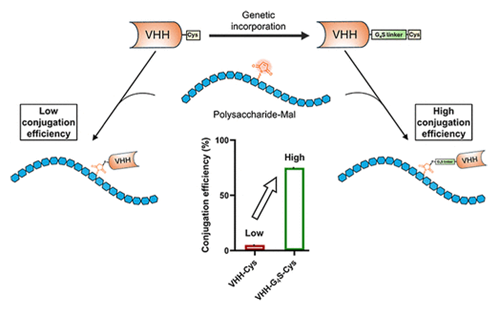Genetic Engineering of VHH Antibodies Enables Precise Conjugation to Polysaccharides Using Thiol–Maleimide Chemistry

In the growing field of antibody engineering, site-selective protein conjugation has become a powerful tool for generating multifunctional biotherapeutics and diagnostics. A new study has demonstrated a universal and highly efficient method to conjugate VHH antibody fragments (single-domain antibodies) to polysaccharides, using thiol–maleimide chemistry—a reaction known for its specificity and biocompatibility.
At the heart of this strategy is the genetic engineering of VHHs with unpaired cysteine (Cys) residues at their C-terminus. These engineered tags serve as precise conjugation sites for maleimide-activated polysaccharides, such as dextran-maleimide (Dex-Mal) and hyaluronic acid-maleimide (HA-Mal), enabling clean, site-specific linkage without interfering with antigen-binding activity.
In the study, six VHHs were engineered for conjugation. While some showed high reactivity, others—such as an anti-TNFα VHH—initially exhibited low conjugation efficiency (<20%). Interestingly, this limitation was overcome by introducing a flexible G4S glycine-serine linker between the variable domain and the C-terminal Cys, restoring full conjugation efficiency. Further enhancement was achieved by adding two free Cys residues in the tail, boosting reactivity for more robust conjugation.
This work highlights how structural tailoring of VHH antibodies can unlock new possibilities in glycan-targeted delivery, biomaterials, and conjugate vaccine design. By achieving precise, stable, and function-preserving attachment to polysaccharides, VHHs can now be more effectively integrated into complex biological platforms.
At AlpalifeBio, we believe this represents a major step forward in programmable nanobody engineering—making VHHs not just powerful binding domains, but also versatile building blocks for next-generation biologics.
Applications Ahead:
Targeted delivery platforms combining nanobody specificity with glycan-based targeting
Nanobody–glycan conjugate vaccines for infectious disease and cancer
Diagnostic probes using site-specific, orientation-controlled antibody labeling
Hydrogel or biomaterial integration using HA or Dex backbones
This genetically encoded conjugation system allows researchers and biotech innovators to design bioconjugates with unprecedented precision. As this method is further refined, it holds potential to improve the safety, stability, and efficacy of a wide range of antibody-based products.
If you're interested in collaborating, customizing your own VHH–polysaccharide platform, or learning more about how AlpalifeBio can support conjugation strategies—we'd love to hear from you.
Reference: ACS Publications